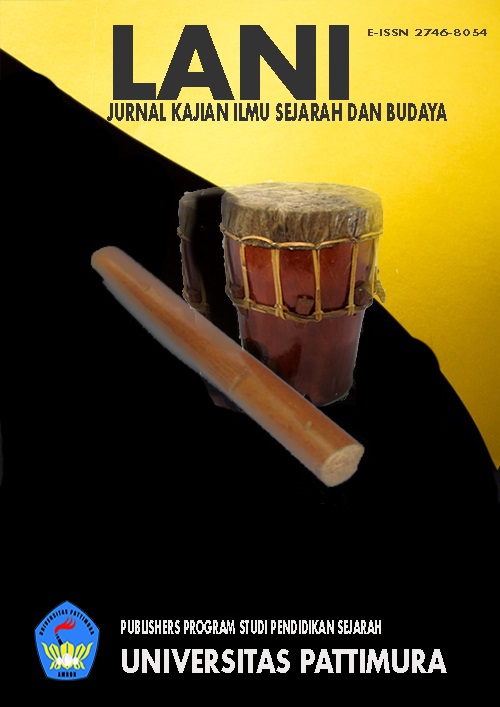Nilai Pancasila Dalam Jejaring Folklore Pela Di Maluku
Pancasila Values in the Folklore Network of Pela in Maluku
Abstract
This article examines how local genius within communities has given rise to tangible societal idioms. The purpose of this article is to demonstrate that the values implied in Pancasila serve as a social capital for the Indonesian state. Pancasila, as the foundational ideology of the state, faces challenges due to ideological conflicts and acts of terrorism that threaten the unity of the nation. In the context of Maluku, the values of Pancasila have inherently existed within the bonds of Pela. Since the time of their ancestors, the people of Maluku have upheld a philosophy of brotherhood, even before the emergence of Pancasila democracy. For instance, the author’s research findings related to the harmonious brotherhood between Muslims and Christians are evident in the relationships between the four Pela villages: Haya (Islam), Tehua (Islam), Hatu (Christian), and Wassu (Christian). The values of Pela, upheld by the people of Maluku, extend beyond religious diversity; they are manifested in everyday interactions, where these four villages support each other in economic, political, and social matters. A qualitative case study approach was used to explore the Pela culture of the Maluku people, which embodies the values of Pancasila. Data was collected through direct observation, with the research conducted in the villages of Haya, Hatu, Tehua, and Wassu. Interviews were conducted with local government officials and community members. In addition to field data, the author sought secondary data through literature, including books and scientific journals. This study reveals that the Pela relationship embodies the integrative values inherent in Pancasila.
Downloads
References
Anggono, B. D., & Damaitu, E. R. (2021). Penguatan Nilai-Nilai Pancasila Dalam Pembangunan Nasional Menuju Indonesia Emas. Pancasila: Jurnal Keindonesiaan, 01(01), 34–44. https://doi.org/10.52738/pjk.v1i1.22
Cresswel, J. W. (2014). Research Design_ Qualitative, Quantitative, and Mixed Methods Approaches. In Sage Publication. Sage Publication.
Dieter Bartels. (2017). Di Bawah Naungan Nunusaku Muslim-Kristen Berdampingan Di Maluku Tengah (1st ed.). Jakarta : KPG (Kepustakaan Populer Gramedia)1-384.
Dundes, A. (2017). The Study of Folklore in Literature and Culture: In Folk Groups And Folklore Genres Reader. https://doi.org/10.2307/j.ctt46nxcv.37
Izak Yohan Matriks Lattu. (2014). Orality and interreligious relationships: The role of collective memory in Christian-Muslim engagements in Maluku, Indonesia.
Khasri, M. R. K. (2021). Pancasila Dalam Praksis Sosial: “Manusia Pancasila” Menjawab Permasalahan Masyarakat Digital. Pancasila: Jurnal Keindonesiaan, 01(01), 86–97. https://doi.org/10.52738/pjk.v1i1.5
Lokollo, J. E. at. al. (1997). (1997). Seri Budaya PelaGandong dari Pulau Ambon. Ambon:
Patittingi, F., Irwansyah, I., Hasrul, M., Arisaputra, M. I., & Yunus, A. (2021). Relasi Negara Dan Agama Dalam Peraturan Daerah Bernuansa Syariah: Perspektif Pancasila. Pancasila: Jurnal Keindonesiaan, 01(01), 17–33. https://doi.org/10.52738/pjk.v1i1.1
Paul Ransome. (2010). Social theory for beginners (1st ed., p. 496). Bristol University Press, Policy Press.
Ruhulesin, J. C. (2005). Etika Publik: menggali dari tradisi Pela di Maluku. Universitas Satya Wacana.
Salakory, R. P. J. M. (2020). TEONG NEGERI: SAKRALITAS IDENTITAS LOKAL MASYARAKAT NEGERI ADAT DI MALUKU TENGAH. Paradigma: Jurnal Kajian Budaya. https://doi.org/10.17510/paradigma.v10i3.382
Salakory, R. P. J. M., Lattu, I. Y. M., & Pilakoannu, R. T. (2020). Teong Negeri: Sentralitas Folklore Nama Lokal Komunitas dalam Jejaring Sosio-Kultural Islam Kristen di Maluku. Jurnal Antropologi: Isu-Isu Sosial Budaya. https://doi.org/10.25077/jantro.v22.n1.p70-80.2020
Watloly, A. (2005). Maluku Baru: Bangkitnya Mesin Eksistensi Anak Negeri. Kanisius.
Yulius Slamet. (2006). Metode Penelitian Sosial. UNS Press.
Copyright (c) 2022 Revaldo Pravasta Julian MB Salakory

This work is licensed under a Creative Commons Attribution-ShareAlike 4.0 International License.








